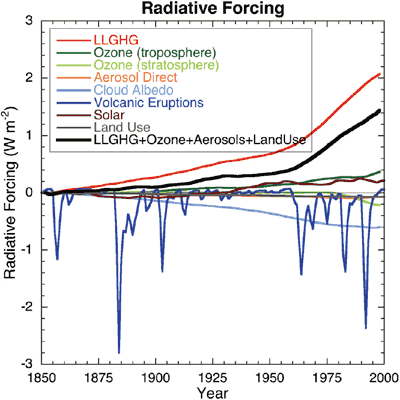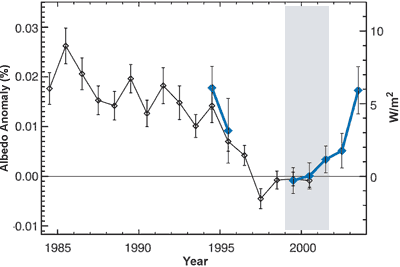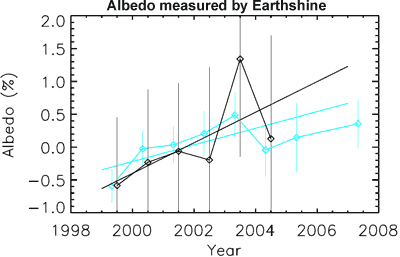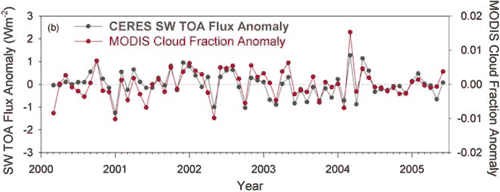The albedo effect
Posted on 5 November 2009 by John Cook
Change to the Earth's albedo is a powerful driver of climate. When the planet's albedo or reflectivity increases, more incoming sunlight is reflected back into space. This has a cooling effect on global temperatures. Conversely, a drop in albedo warms the planet. A change of just 1% to the Earth's albedo has a radiative effect of 3.4 Wm-2, comparable to the forcing from a doubling of CO2. So is it unreasonable to wonder if albedo might have something to do with this global warming caper?
Albedo trends before 2000
There are various factors that affect the Earth's albedo. Snow and ice are highly reflective so when they melt, albedo drops. Forests have a lower albedo than open land so deforestation increases albedo (but for the record, no, chopping down all our forests is not the solution to global warming). Aerosols have a direct and indirect effect on albedo. The direct effect is by reflecting sunlight back into space, cooling the Earth. The indirect effect is when aerosol particles act as a cloud condensation nucleus, affecting the formation and lifetime of clouds. Clouds in turn influence global temperatures in various ways. They cool the climate by reflecting incoming sunlight but can also warm the climate by trapping outgoing infrared radiation from the surface.
All these factors are considered when adding up the various radiative forcings that drive climate. Changes in land use are calculated from historical reconstructions of cropland and pastureland changes. Combinations of satellite and surface-based observations allow us to determine trends in aerosol levels as well as cloud albedo effect.

Figure 1: Globally and annually averaged radiative forcing (Chapter 2 of the IPCC AR4).
What we observe is that of the various albedo forcings, cloud albedo is the most dominant effect. The long term trend is that of cooling with a radiative forcing from 1850 to 2000 of -0.7 Wm-2.
Albedo trends since 2000
One method to determine the Earth's albedo is to measure earthshine. This is sunlight reflected from the Earth and then reflected from the Moon back to the nighttime Earth. Earthshine has been measured at the Big Bear Solar Observatory since November 1998 (with some measurements in 1994 and 1995). Figure 2 shows changes in albedo calculated in Palle 2004 from reconstructed satellite data (black line) and Earthshine measurements (blue line).

Figure 2: Albedo anomalies reconstructed from ISCCP satellite data (black) and Earthshine-observed albedo anomalies (blue). The right hand vertical scale shows negative radiative forcing (eg - cooling) (Palle 2004).
The data in Figure 2 is problematic. The black line, reconstructed from ISCCP satellite data, "is a purely statistical parameter that has little physical meaning as it does not account for the non-linear relations between cloud and surface properties and planetary albedo and does not include aerosol related albedo changes such as associated with Mt. Pinatubo, or human emissions of sulfates for instance" (Real Climate).
Even more problematic is the spike in albedo around 2003, shown by the blue earthshine line. This is in sharp contrast to satellite measurements which showed little to no trend over the same period. To put this in perspective, consider the Pinutabo volcanic eruption in 1991 which spewed aerosols into the atmosphere. These aerosols reflected incoming sunlight, causing a negative radiative forcing of 2.5 Wm-2. This led to a dramatic drop in global temperatures. The earthshine data indicated a radiative forcing of nearly -6 Wm-2 which should've caused a precipitous drop in global temperatures. No such drop occured (Wielicki 2007).
In 2008, the reason for the discrepancy was discovered. The Big Bear Solar Observatory installed a new telescope in 2004 to measure earthshine. With the new and improved data, they recalibrated their old data and updated their earthshine albedo results (Palle 2008). Figure 3 shows the old albedo data (black) and the updated albedo (blue). The anomalous 2003 spike disappears. Nevertheless, a trend of increasing albedo remains from 1999 to 2003.

Figure 3: Earth albedo anomalies as measured by earthshine. In black are the albedo anomalies published in 2004 (Palle 2004). In blue are the updated albedo anomalies after improved data analysis, which also include more years of data (Palle 2008).
How accurate is the earthshine method in determining global albedo? For starters, the method doesn't give a global albedo estimate. It covers about one third of the Earth at each observation occasion and certain areas can never be ‘‘seen’’ from the measurement site. Furthermore the measurements are sparsely sampled in time, and only made in a narrow wavelength band of 0.4 to 0.7 µm (Bender 2006).
In contrast, satellite data such as CERES is a truly global measure of the Earth’s reflected shortwave radiation, including the effects of all atmospheric and surface properties. It covers a broader spectrum than earthshine (0.3–5.0 µm). Loeb 2007a compares 4 independent sets of satellite data: CERES, MODIS, MISR and SeaWiFS. Albedo as measured by CERES shows no long term trend from March 2000 to June 2005. They also find "remarkable consistency" between the 4 satellite results.

Figure 4: Monthly anomalies in global mean CERES SW TOA flux and MODIS cloud fraction (Loeb 2007b).
So albedo has had an effect on global temperatures - mostly a cooling effect on long term trends. As for recent albedo trends, earthshine data shows increasing albedo from 1999 to 2003 but little to no trend from 2003. Satellites show little to no trend since 2000. The radiative forcing from albedo changes in recent years appears to be minimal.
For more info, see Papers on the albedo of the Earth by AGW Observer.































 Arguments
Arguments






























The doubts about CO2 warming effects have never so far been answered by useful dialogue describing in compelling ways how CO2 warming actually happens. Let me offer the following:
The sun warms the earth but about 30% of the sun's energy is reflected back into space by snow and ice, which perfectly reflect the wavelengths of energy coming from the sun. The atmosphere is transparent to the sun's energy so all that reflected energy escapes to space. The other 70% is absorbed by the earth and then re-radiated at longer wavelengths. Most of those wavelengths pass on through to space but a cluster around 15 nanometers is absorbed by CO2 and then re-radiated, half toward space half toward earth. That incoming 15 nanometer energy is not reflected by snow and ice. Instead they absorb it completely and it causes them to melt. That's why glaciers all over the world are melting (not because the air is warmer). That also explains why the sea ice in the Arctic has been disappearing in the summer. Now that the ice is gone the energy of the summer sun beams down on open Arctic water instead of ice and is absorbed instead of being reflected. That changes the energy balance of the earth. The effective albedo around the North Pole has changed enormously. I submit that this is probably the largest contributor to global warming and find it more than strange that nobody seems to have commented on this as a compelling explanation of global warming.
cMike... Your description is okay, but it's really only one piece of the puzzle, and is something that's been well understood for many decades. There's quite a lot more science involved to explain how CO2 operates in the atmosphere to warm the planet. We have lots of articles here at SkS that you can read. A good place to start is the SkS welcome page.
cMike @84, first many people have produced good, sucinct explanations of the greenhouse effect. Here at Skeptical Science you have two such explanations by Chris Colose (The Planatery Greenhouse Engine Revisited; and Joseph Postma and the Greenhouse Effect Pts 1 & 2). Pitched for easier comprehension, there is also my post on the subject (which, of course, I recommend).
Beyond that, your explanation contains a number of small, and one larger error. The larger error is that greenhouse gases do not simply reemitt the energy absorbed by radiation. Instead that energy is typically transfered to other molecules by collisions as either kinetic energy or changes in excitation states. In short it is thermalized, that is converted into kinetic heat energy. At the same time, a certain percentage of greenhouse gas molecules will always be in an excited state because the temperature of a gas, with the percentage depending on the temperature of the gas. That means the greenhouse gases will radiate at a rate dependent on their temperature, with the radiation going equally in all directions.
With regard to minor points, Ice has an albedo around 0.9, but snow has an albedo that depends on its age, and varies from 0.5-0.9, with lower values to be found in older snow. That is very important because typically sea ice is covered by snow. Further, clouds alone add an albedo of about 0.2 to the Earth, but the total albedo is only 0.3 because of overlap.
Finally, here are the relative strengths of various feedbacks as determined by the IPCC AR5:
P is the Planck feedback, which determines the temperature response to a forcing with no other feedbacks. WV is the Water Vapour feedback. LR is the Lapse rate feedback. WV&LR is the Water Vapour plus Lapse Rate feedback. They are shown coupled like that because they are related to each other, with the result that uncertainty is the combined feedback is much less than that in each seperately. C is the cloud feedback, which is the most uncertain of all the major feedbacks. Finally, A is the albedo feedback from changes in ice and snow. It is 18.75% of the strength of the water vapour feedback, which is the strongest of the positive feedbacks.
The figure is Figure 9.43 and the tabular data from which I calculated relative strength is from Table 9.5.
Thanks to all of you who read my post. It had been quite a while since the previous one. I was attracted to this site because I was looking for albedo related facts, especially related to the delta effect of the loss of arctic sea ice. I have read extensively about global warming and actually do know about the role of water vapor (i.e., the water cycle), clouds as contributors to the albedo effect and the thermal heating aspects of CO2 on the atmosphere. That said, assertions that things are more complicated than what I included, while true, kind of miss the point.
Focusing on thermal warming of the atmosphere suggests that it is the atmosphere's warming that is the problem. Yet the truth about global warming is that it is ultimately about warming of the oceans and the temperature of the air is almost irrelevant compared to the solar energy impinging on the oceans and the evaporative cooling that offsets it. In other words the heat transfer from air to water is negligible. So what would warm the oceans? My first post posits a mechanism: solar warming of arctic seas no longer hidden under sea ice. What I had hoped to find was some analysis that computed the area of lost ice and calculated the difference in reflectance between ice (ok 90% isn't perfect) and water to estimate the added energy absorbed. I keep hearing comments about how much greater the effects of "global warming" are in the arctic but never a why. I'm describing the why here and hope somebody can help quantify it.